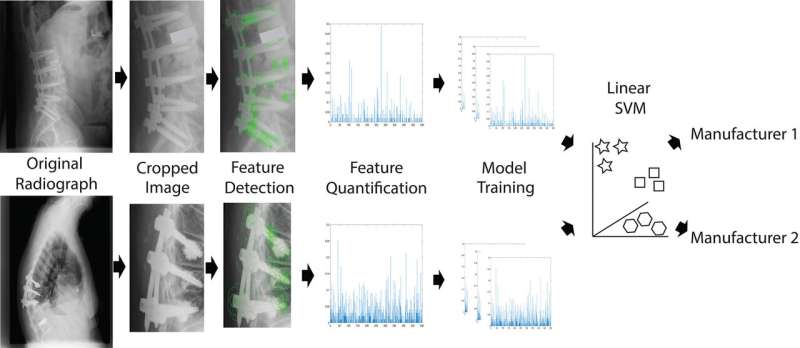Computer vision is superior to surgeons in identifying spinal implants, shows study

Identifying previously placed spinal hardware can be difficult and time consuming when a patient needs revision surgery. Detailed information on the implant model and type are often lacking when patients are referred elsewhere or may be missing in the surgical notes. To overcome this challenge, researchers developed a computer vision machine learning approach that more accurately and efficiently identifies previously placed thoracolumbar instrumentation.
The study detailing the computer vision model was published today in the Journal of Neurosurgery: Spine.
To build their computer vision classifier, Dr. Alexander E. Ropper and colleagues used 1,072 radiographs showing postoperative views of placed thoracolumbar instrumentation manufactured by five different device companies. Each image was labeled with the device implanted, and a bag-of-visual-words technique utilizing KAZE feature detection was used to construct a computer vision support vector machine classifier.
Accuracy rates for binary classification of the two most commonly placed systems for lateral, anteroposterior, and fused images were 93.15%, 88.98%, and 91.08%, respectively, although accuracy decreased by 10% with each manufacturer added. The computer vision model outperformed two surgeons and three manufacturer representatives in both accuracy (79% versus 44%) and completion time (14 seconds versus 20 minutes). Further steps to improve the model's accuracy include increasing the number of images per manufacturer to ensure an even distribution.
When asked about the study, Dr. Ropper said, "This computer vision machine learning model will be able to assist surgeons in planning revision instrumented fusions. By accurately and quickly identifying existing hardware based on standard radiographsbefore a revision surgery, both surgeons and operating room staff will be better prepared to remove or revise the hardware."
More information: Adrish et al, A computer vision approach to identifying the manufacturer of posterior thoracolumbar instrumentation systems, Journal of Neurosurgery: Spine (2022), DOI: 10.3171/2022.11.SPINE221009. thejns.org/spine/view/journals … 2.11.SPINE221009.xml




















